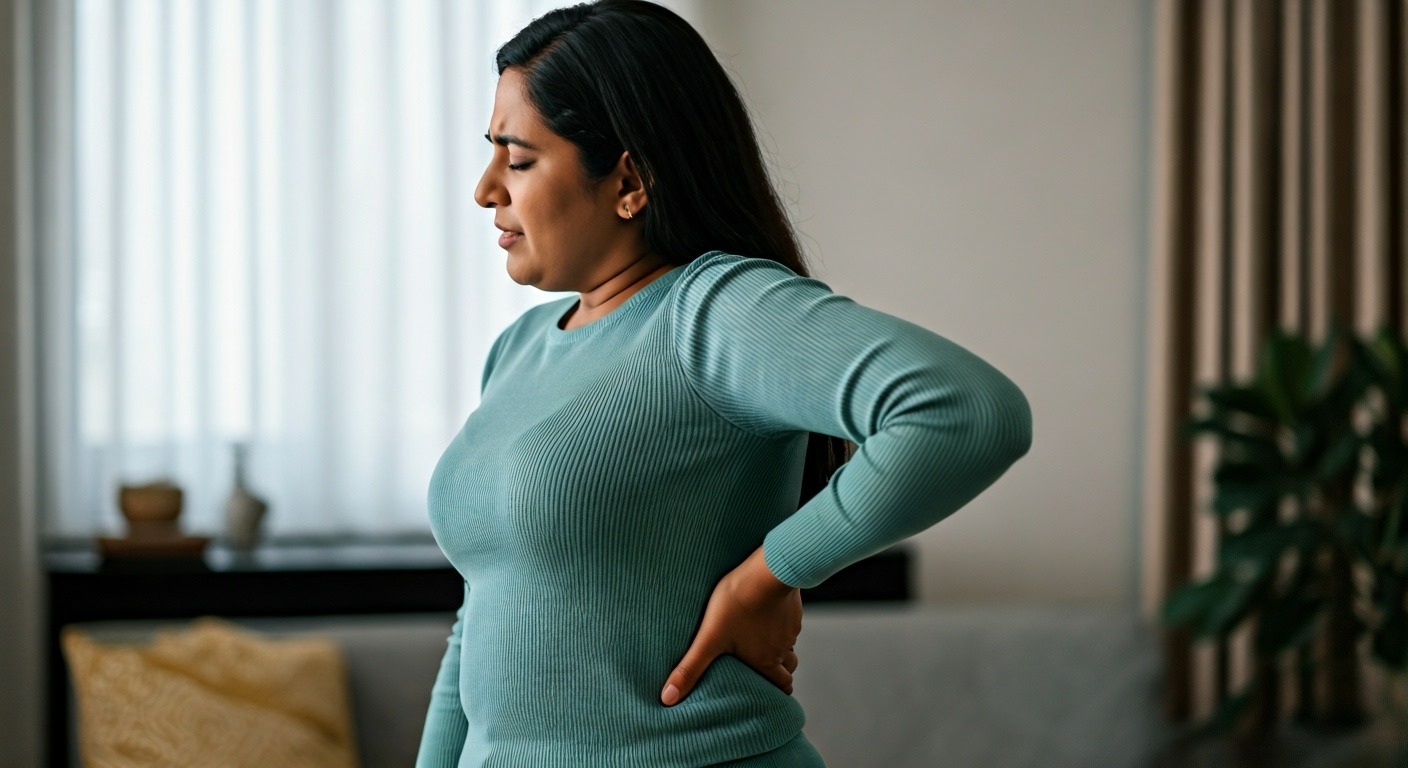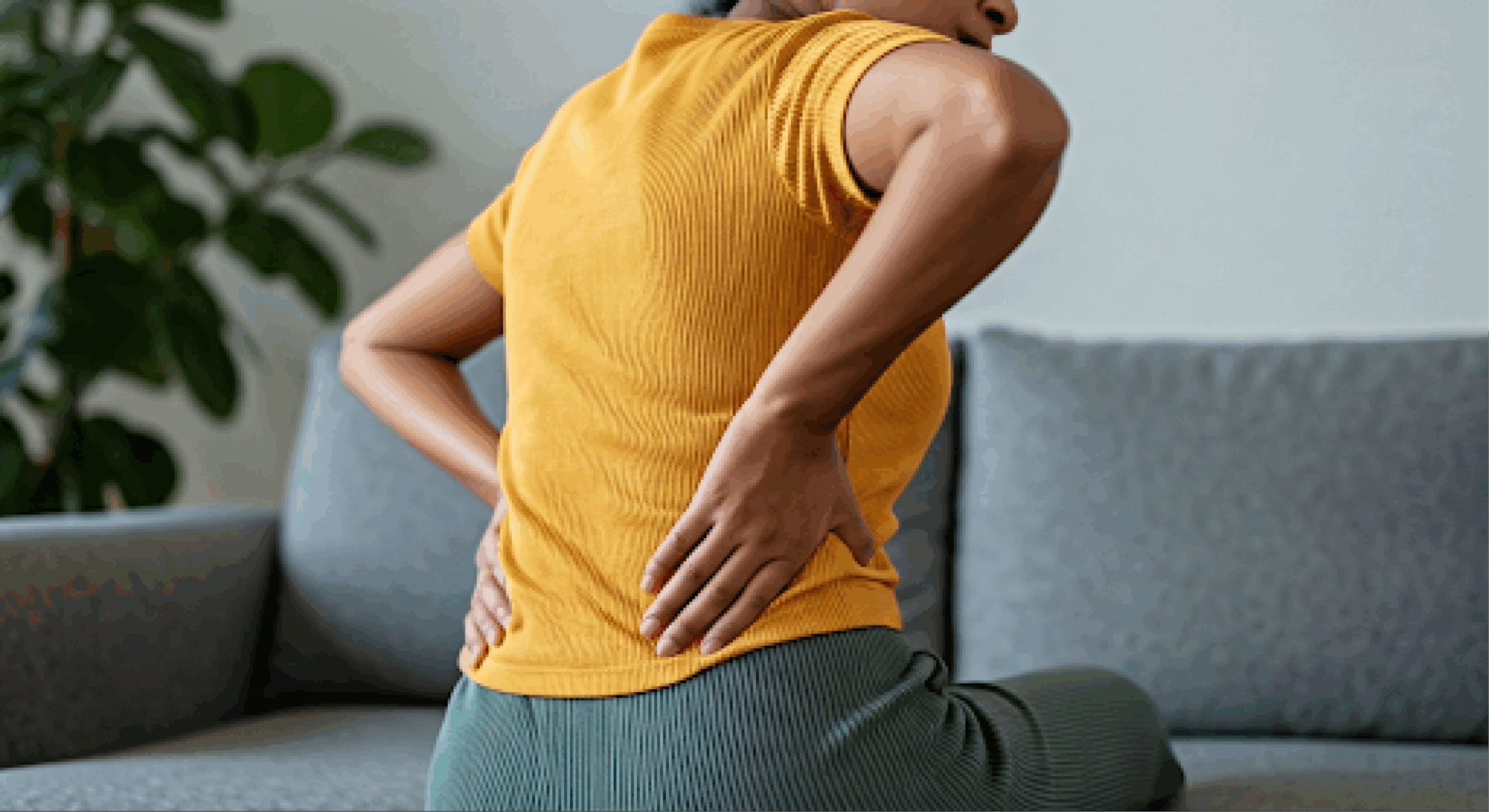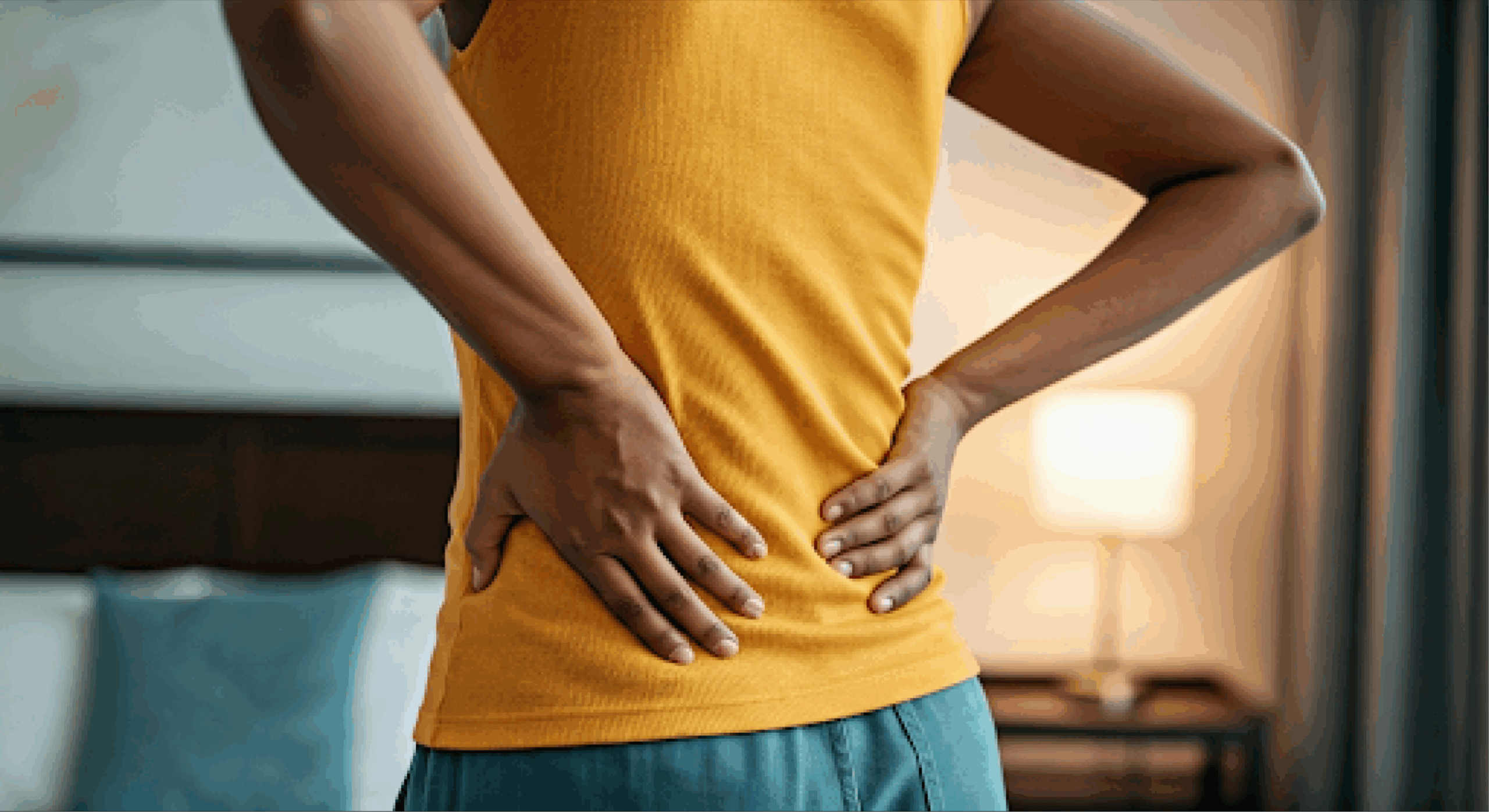

Lower back pain is a common problem for many women. It can come from both structural problems and issues related to women’s health.
Common causes include muscle strain, bad posture, sitting too much, and body differences that are unique to women.
Some factors only women face include cramps during periods, endometriosis, pregnancy, ovarian cysts, and fibroids. These increase the chance of back pain.
Changes in hormones during the menstrual cycle and reproductive years can cause or make back pain worse.
Health problems like urinary tract infections and pelvic inflammatory disease can also cause pain in the lower back.
Taking care of these risk factors and managing pain early can help give long-lasting relief. This can make daily life better.
Lower back pain can break your daily routine and affect your health. For women, this pain is often caused not just by common strains or injuries but also by conditions specific to them. Things like hormonal changes, reproductive health, posture, and daily habits all play a role in how often you get back pain. When you know the reasons, you can find the right ways to feel better. If a sore lower back is stopping you from doing your usual activities, the first step to real relief is to understand why it happens.

Lower back pain in Indian women often comes from a mix of lifestyle habits and health problems. Lifting heavy things, bad posture, or sitting for a long time can cause pain. This is more common for women who have busy days or desk jobs. Also, body differences and hormone changes at different life stages can make women more likely to have lower back pain. Knowing these risk factors can help you take steps to reduce pain and feel better every day.
Now, let’s look at muscle strain, poor posture, and lifestyle habits that affect back pain before we talk about health issues specific to women.
Musculoskeletal strain is one of the main reasons women have back pain. Simple daily actions like lifting laundry, carrying kids, or bending the wrong way can make the back muscles tired. This can cause aches or sudden sharp pains. Sometimes, people even hear a “pop” when a muscle or tendon is overstretched.
Bad posture makes this problem worse. Sitting hunched over a laptop or standing unevenly because of heavy bags can make the lower back lose its right position. This makes some muscles work harder, causing ongoing pain and stiffness.
Did you know that keeping good posture during daily tasks can lower your chances of getting hurt again? Try to keep your ears, shoulders, and hips in line! If you make good posture a habit, your back muscles will get stronger over time. This will help reduce back pain and prevent it from coming back.
A lifestyle with little movement weakens key muscles that support your back. This raises the chance of back pain. Many Indian women spend a lot of time sitting—at their desks, in cars, or while relaxing. This causes muscle imbalances in the lower back and belly, which can lead to discomfort.
Moving every day is very important for a healthy back. Without regular exercise:

Many women do not know that problems with their reproductive organs can cause pain in the lower back. Changes in the menstrual cycle, or conditions like endometriosis and adenomyosis, can cause both pelvic pain and back pain. These issues are often confused with regular muscle pain. This mistake can delay the right treatment.
Knowing how gynecological health and lower back pain are connected helps you see warning signs early. This way, you can get help sooner and avoid extra pain.
Menstrual cramps, or dysmenorrhea, can cause lower back pain in women. During periods, the uterus contracts, which causes these cramps. The pain can spread to the lower back. This happens because of inflammatory chemicals called prostaglandins. Drinking enough water, exercising, and eating a balanced diet can help ease these symptoms. Also, putting heat on the lower back or using over-the-counter pain relievers may help with the back pain.
Endometriosis and adenomyosis are long-lasting women’s health problems. In these, the uterine lining grows outside or inside the muscle of the uterus. This causes ongoing pain in the lower back and pelvis. Many women find that this pain gets worse during their periods but can stay for the whole month.
The pain from endometriosis feels like a deep ache near the lower spine. It often spreads to the belly or pelvic area. Adenomyosis causes a heavy, pulling feeling with strong back pain, mainly during periods.
Both of these problems can affect a woman’s chance to have children and how well she feels day to day. Treatments include pain management, hormone medicines, and sometimes surgery for the worst cases. It is important to treat the causes of lower back pain early. This helps women feel better and get back to their normal life faster.
Reproductive health problems often connect to back pain. This is usually because of hormonal changes, body shifts, or the physical strain from pregnancy. These things can cause pain in the lower back. They can also affect the abdominal muscles and the way the pelvis lines up.
It is important to learn how hormone changes and body changes during key times can lead to back pain. When you know how your reproductive health links to your spine, you can watch for problems early. This helps you take action before the pain gets worse.
Let’s look at changes from pregnancy and other issues like ovarian cysts and uterine fibroids.
Pregnancy introduces dramatic changes to posture, muscles, and the spine. As the baby grows, your center of gravity shifts forward, increasing the curve in the lower back. Abdominal muscles stretch and weaken to accommodate the expanding uterus, leaving the lower back more vulnerable to pain.
Hormonal changes during pregnancy also soften ligaments and joints, particularly in the pelvis, causing further strain on the lumbar region.
Change During Pregnancy
Effect on Lower Back
Center of gravity shifts
Increases stress on lower back muscles
Abdominal muscles weaken
Reduces spinal support, raises pain risk
Hormonal ligament relaxation
Causes joint instability in pelvis/spine
Hormonal ligament relaxation
Causes joint instability in pelvis/spine
Weight gain
Adds to the physical load on the back
Gentle exercises, good posture, and supportive devices like maternity belts can all help. If back pain becomes severe or persistent, consulting with a medical provider is crucial to ensure you and your baby stay safe and healthy.
Ovarian cysts are sacs filled with fluid that form on the ovaries. Uterine fibroids are noncancerous lumps that grow in the uterus. Both can cause pressure in the pelvic area and lower back pain. This happens especially when they get big or press on nerves and muscles in the pelvis.
The symptoms are not just in the back. People may also feel pain in the belly, bloating, heavy periods, or changes in urination. When these growths affect nearby tissues, they can weaken the abdominal muscles. This can increase the pain.
Most small cysts go away on their own. But bigger growths or ongoing pain may need medical care. Treatment can include medicine, hormone therapy, or surgery if needed. Getting help early can stop problems and ease both back pain and pelvic pain. It also helps protect your reproductive health
Not all pain in the lower back comes from muscles or the reproductive system. Some other medical conditions can also cause pain there. Infections, problems with the kidney or bladder, sciatica, and inflammation can all cause pain in the lower back.
Knowing which medical conditions can cause lower back pain helps to manage the pain better. Watching for other signs like fever, trouble with urine, or unexplained weight loss is very important. These signs can help you get help early and avoid more problems.
The next part will talk about two common causes: urinary infections and pelvic infections.
Urinary tract infections (UTIs) and kidney problems often cause lower back pain in women. UTIs can make the bladder sore and cause pain in the lower back area. Kidney infections can bring more severe pain in the back and sides. It is important to deal with these problems quickly to avoid more serious issues.
You should see a doctor to get the right diagnosis and treatment for lower back pain caused by UTIs and kidney problems.y need medical care. Treatment can include medicine, hormone therapy, or surgery if needed. Getting help early can stop problems and ease both back pain and pelvic pain. It also helps protect your reproductive health.
Pelvic Inflammatory Disease (PID) and infections can cause lower back pain in women. PID is often caused by sexually transmitted infections like chlamydia or gonorrhea. This can lead to pain in the lower back. Infections in the reproductive organs can also cause back pain because they are close to the lower back area.
It is important to see a doctor quickly to treat these problems and reduce the pain. Knowing how infections relate to lower back pain helps with the right diagnosis and good treatment.
Lower back pain in women can come from many different causes. Knowing what causes the pain is important to manage it well. It could be from muscle strain caused by bad posture, problems related to gynecology like endometriosis, or other health issues such as pelvic inflammatory disease.
Finding out the real cause helps to get the right treatment. It is important to deal with these symptoms early and make changes in your daily habits to stop long-term pain. By listening to your body and asking a doctor when needed, you can take steps to feel better and improve your health. If you have more questions or worries about your lower back pain, don’t wait to ask for a consultation.
You should visit a doctor if your lower back pain is very bad or lasts more than a few days. Also, see a doctor if you have unexplained weight loss, fever, numbness, or loss of control over your bowel or bladder. These might be signs of a medical emergency or a serious underlying cause.
Yes, changes in hormones—especially during the menstrual cycle or premenstrual syndrome—can cause swelling, hold fluid, and make the lower back feel sensitive. These changes can make back pain worse, especially in the days before a period.
Keeping a healthy weight, using good posture, doing regular physical therapy or exercises to build up the abdominal muscles, and not sitting for too long all help lower your risk of back pain. These steps can protect you for a long time and make you feel more comfortable.
Yes, home remedies like pain relievers, heat therapy, gentle stretching, and rest can help a lot to ease back pain. Using a warm pack on your back muscles helps relax tightness and lowers pain. This is great for relieving mild or short-term back pain.
No, the causes of lower back pain in women are not always related to gynecological problems. Strain in the muscles and bones, degenerative disc disease, arthritis, or other medical conditions can also lead to lower back pain. It is important to see a doctor to find the underlying cause and get the right treatment.

Pioneering Interventional Pain Management
Delhi | Faridabad | Gurugram | Ghaziabad | Noida | Lucknow | Jaipur | Mumbai
© 2025 Nivaan. All Rights. Reserved